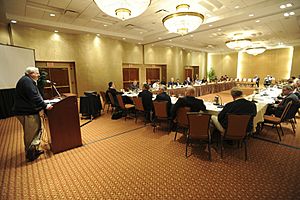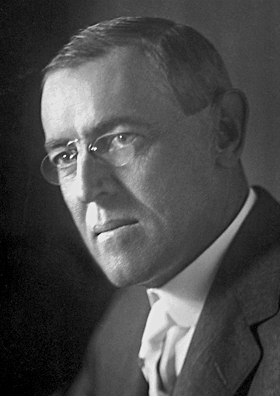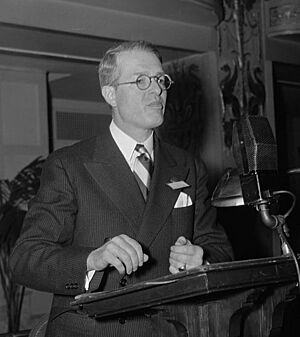Public administration facts for kids
Public administration, often called public policy and administration, is all about how governments manage their daily tasks and make sure things run smoothly for citizens. Think of it as the way decisions made by politicians become real actions that affect everyone.
It's also a field of study that looks at how governments make choices, how policies are created, and what happens when they are put into action. Public administration is a big part of political science, which studies how governments work and how they connect with society. The main idea is that for any group or government to work well, it needs good management.
In the mid-1900s, a German thinker named Max Weber talked a lot about how governments use "bureaucracy" (organized systems with rules and officials). This made people more interested in the ideas behind public administration. Later, in 1968, a meeting called the Minnowbrook Conference led to a new idea called New Public Administration, which is still important today.
Contents
What is Public Administration?

Public administration is about carrying out, watching over, and managing government plans and public matters. It involves how government groups are set up, how they operate, and how they work together. Public administrators are important because they help create and carry out policies, manage shared resources, and make sure government agencies and programs work well.
In 1947, Paul H. Appleby said public administration is "public leadership of public affairs directly responsible for executive action." In countries with democracies, this leadership usually respects and helps the dignity and potential of citizens. A year later, Gordon Clapp said it helps a democratic society become "more completely realized." This means it should care about fairness, freedom, and better chances for people.
Many experts today say there isn't one simple definition for public administration. This is because it covers so many different things. It's both a field of study and a job. Some see it as part of political science, while others see it as part of administrative science.
The North American Industry Classification System (NAICS) says public administration includes government activities. This means making and interpreting laws, and running programs based on those laws. It covers things like making laws, collecting taxes, national defense, public safety, and managing government programs.
A Look at Public Administration History
Early Beginnings in India
Even thousands of years ago, civilizations like Harappa and Mohenjo-daro in ancient India had organized groups of public servants. This shows that some form of public administration existed. There are also old writings that talk about rules and governance. For example, some ancient thinkers focused on "good work, fair administration, and welfare plans" for people. This suggests that leaders were thinking about how to manage society well.
While we don't have many records of kings or palaces from these very old times, the existence of large cities and public facilities like granaries (places to store grain) and bathhouses suggests there was a central government. The fact that artifacts and brick sizes were similar across different areas also points to some kind of organized leadership.
From Ancient Times to the 1800s
For a very long time, governments needed officials like treasurers and tax collectors to handle their daily business. Before the 1800s, jobs in public administration often went to family members or friends, or were given out as political favors. This was sometimes called a "spoils system".
Public administrators were like the "eyes and ears" of rulers. In medieval times, only educated people could read, write, and do math. So, public jobs were often held by this elite group. As empires grew, the need for skilled civil servants who could keep records, pay armies, and collect taxes became even more important.
China's Early Influence
The idea of good management might have started in ancient China. China had one of the first highly organized governments with many officials. It also had the earliest system (around 200 BC) where people got government jobs based on their skills, proven by tests. China was seen as very advanced in public administration until the late 1700s.
British officials visiting China in the 1800s were impressed. Thomas Taylor Meadows said China's long-lasting empire was due to "advancement of men of talent and merit only." This idea influenced how Britain and France set up their own government services. The British Northcote–Trevelyan Report of 1854 suggested that government jobs should be given based on competitive exams and merit. This led to Britain's modern, skill-based civil service.
Europe in the 1700s
In the 1700s, King Frederick William I of Prussia started special university courses called "Cameralism." These courses trained new public administrators. Universities focused on economic and social studies to help improve society.
Later, in 1855, Lorenz von Stein from Vienna was seen as the founder of public administration as a science in many parts of the world. He believed public administration used ideas from many fields like sociology, political science, and public finance. He said it was a science because knowledge in this field could be created and tested using scientific methods.
Public Administration in the United States
In the US, Woodrow Wilson is often called the "father of public administration." In 1887, he wrote an important article called "The Study of Administration." He said the goal was to find out what government could do well and how it could do those things most efficiently and cheaply.
By the 1920s, many books were written about public administration. Important thinkers like Luther Gulick, Lyndall Urwick, and Frederick Taylor contributed to the field. Taylor believed that scientific study could find the "best way" to do any task. His ideas were used in businesses and later in government.
The American Society for Public Administration (ASPA), a main group for public administrators, was started in 1939. The National Academy of Public Administration (NAPA) is another important group. It does research to help improve government and solve its biggest challenges.
The 1940s: New Ideas Emerge
Wilson had suggested that politics and administration should be separate. But in the 1940s, new thinkers challenged this idea. Luther Gulick was one of them. He believed that politics and administration were closely linked.
Gulick, Urwick, and others built on the work of earlier thinkers like Henri Fayol and Frederick Taylor. They looked at how organizations work and how people behave within them. Gulick created a famous acronym, POSDCORB, to describe the duties of administrators: planning, organizing, staffing, directing, coordinating, reporting, and budgeting. These new ideas suggested that management principles could apply to both private businesses and government.
The 1950s to 1970s: Challenges and Changes
In the 1950s, after World War II, the US was doing well, and the government was popular. Public administration also thrived. However, in the 1960s and 1970s, things changed. The costly war in Vietnam and scandals like Watergate made citizens lose trust in the government.

People wanted more efficient government and less waste. Public administration had to adapt. The idea of public administration expanded to include making and analyzing policies. Also, the "human factor" became more important. Studies began to include ideas from psychology, anthropology, and sociology to understand how people interact with government.
Events like the civil rights movement and the women's movement in the 1960s also changed public administration. New laws like the Civil Rights Act of 1964 gave public administrators new duties. This led to the "new public administration" movement, which focused on making public administration more relevant, fair, and open to change. It encouraged more participation from women and minorities.
The 1980s and 1990s: New Public Management
In the late 1980s, a new idea called New Public Management (NPM) became popular. This approach suggested that governments should use ideas and methods from the private sector (businesses) to become more efficient and serve citizens better. During the Clinton Administration, Vice President Al Gore used NPM ideas to reform federal agencies. NPM became common in governments in the US, UK, and Canada.
NPM often involves breaking large government groups into smaller ones, encouraging competition between different public agencies, and even between public agencies and private companies. It also uses financial rewards, like performance pay. NPM sees people as "customers" or "clients" rather than just citizens.
Some people criticize NPM because they believe treating people as "customers" is wrong for government. They argue that citizens are the "owners" of the government, not just customers of a business. Despite this, the NPM model is still widely used in many countries and at different levels of government.
Later, new ideas like digital era governance emerged. This focuses on using modern technology and digital storage to make government services better and more connected. Another approach is "New Public Governance," which involves more centralized power and political staff in government.
In the 1980s, community programs in the US aimed for things like independent living and community involvement for all citizens, including those with disabilities. However, by the 1990s, there was a push to make disability policy a separate field within public administration.
Women's Contributions to Public Administration
Recently, scholars have started to recognize another important part of public administration's history: the contributions of women. This is sometimes called the "settlement" model. In the 1800s, wealthy women in the US and Europe formed volunteer groups. They worked to fix problems caused by growing cities and industries, like dirty streets and unsafe workplaces.
These women's groups created networks that helped change policies and administration. They worked to make cities and workplaces safer and better for children, pushing for things like playgrounds, libraries, and child labor laws. These were areas that men often ignored. Their work was boosted by non-profit organizations called Settlement Houses, which were often in poor city areas with many immigrants.
Many reforms from the New Deal (like income for the elderly and unemployment insurance) were supported by leaders of the Settlement movement. Jane Addams, a key leader, is even credited with helping create the modern welfare state. For a long time, the achievements of the Settlement movement were not recognized in public administration literature.
Settlement workers actively fought for social justice. They wanted policy changes that would improve the lives of immigrants, women, children, the sick, the elderly, and the poor. They believed that cities should be run like a caring home, where families are safe and children are looked after. They also worked to fix problems in workplaces, like child labor and unsafe conditions. These efforts led to laws about workplace safety. Many settlement reformers later became government administrators themselves.
Main Areas of Public Administration
In universities, the study of public administration has several main areas. One common way to think about them is using five "pillars":
- How Organizations Work: This looks at how government groups are structured and all the details involved in them.
- Ethics in Public Service: This is about making good, fair decisions in government.
- Policy Analysis and Program Review: This involves studying policies and programs to see if they work well and how they can be improved.
- Public Money Management:
* Public budgeting is about how governments decide to spend limited money to meet many needs. * Public finance studies the government's role in the economy, including how it gets and spends money to achieve good results.
- Managing People in Government: This is about making sure that government jobs are filled fairly and ethically. It includes things like employee benefits, healthcare, and making sure human rights are respected.
Other Important Areas
- Nonprofit Management: This is about how non-profit organizations are run and what impact they have.
- Emergency Management: This is about how communities prepare for and deal with disasters.
- Technology in Government: This looks at how technology helps government services, like online government (e-governance) and digital ways to deliver services.
Studying Public Administration
Universities offer different degrees in Public Administration, Government, or Political Science. These degrees might focus on Public Policy and Administration. Some popular graduate degrees include the Master of Public Administration (MPA) and the Master of Public Policy (MPP).
In the United States, studying public administration often involves ideas from political science and administrative law. Some programs also include economics to help students understand how markets work and how governments manage national debt.
Some experts feel that public administration as a field of study is "struggling to define its role." They note that new ideas often come from outside the field itself.
Public administration theory is where people discuss the meaning and purpose of government, how government systems support democracy, and how budgets and public affairs are managed.
Comparing Public Administration Systems
Comparative public administration (CPA) is the study of how different countries manage their public services. It also compares different administrative systems. There's a group within the American Society for Public Administration that focuses on this.
It can be hard to compare public administration across countries because there are big differences between Western countries and developing countries. Also, there aren't many specific courses on CPA in public administration programs. However, comparing systems helps us understand how different policies work in various situations.
International Groups
There are several international organizations for public administration. The Commonwealth Association of Public Administration and Management (CAPAM) includes 56 countries. The oldest is the International Institute of Administrative Sciences (IIAS) in Belgium.
Other groups include the Center for Latin American Administration for Development (CLAD) in Venezuela, and NISPAcee, which is a network of experts in Central and Eastern Europe. The Eastern Regional Organization for Public Administration (EROPA) is based in the Philippines and works with countries in the Asia Pacific region.
Public Management
"Public management" is a way of running government and non-profit organizations that uses ideas and methods from the private business world. The goal is often to make things more efficient and effective, and to provide better service to citizens. This is different from traditional public administration, which focuses more on the social and cultural reasons why government is unique from the private sector.
Many groups around the world study public management, including:
- In the US: The American Society for Public Administration.
- In Canada: The Institute of Public Administration of Canada.
- In the UK: The Institute of Local Government Studies.
- In Australia: The Institute of Public Administration Australia.
- In France: The École nationale d'administration.
- In Germany: The German University of Administrative Sciences Speyer.
Comparing public management across different governments helps us see how efficient and effective they are.
See also
 In Spanish: Administración pública para niños
In Spanish: Administración pública para niños
- Administration (government)
- Administrative discretion
- Budgeting
- Bureaucracy
- Civil society
- Community services
- Max Weber
- Doctor of Public Administration
- List of Public Administration Journals
- List of public administration schools
- Master of Public Administration
- Municipal government
- Official
- Politics
- Professional administration
- Public policy
- Policy Studies
- Public policy schools
- Teleadministration
- Theories of administration
- The Study of Administration
Societies
- International Institute of Administrative Sciences
- American Society for Public Administration
- Chinese Public Administration Society
- Dutch Association for Public Administration
- Indian Institute of Public Administration
- Joint University Council of the Applied Social Sciences
- Korea Institute of Public Administration
- Royal Institute of Public Administration




